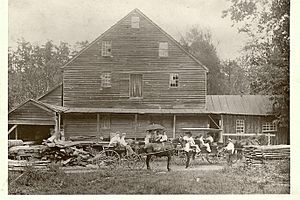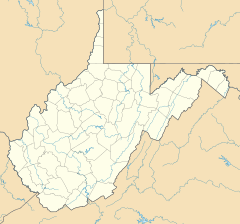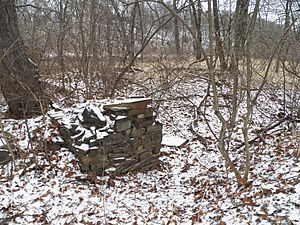Hooks Mills, West Virginia facts for kids
Quick facts for kids
Hooks Mills, West Virginia
|
|
|---|---|
| Country | United States |
| State | West Virginia |
| County | Hampshire |
| Elevation | 869 ft (265 m) |
| Time zone | UTC-5 (Eastern (EST)) |
| • Summer (DST) | UTC-4 (EDT) |
| Area code(s) | 304 |
| GNIS feature ID | 1551487 |
Hooks Mills is a small, unincorporated community in Hampshire County, West Virginia, in the United States. This means it's a group of homes and buildings, not a city or town with its own local government. You can find it on Hooks Mill Road, about 4.5 miles south of Capon Bridge.
The community got its name from the Hook family. They ran a sawmill (for cutting wood) and a grist mill (for grinding grain) on the Cacapon River. These mills were active from 1848 until the late 1930s.
Contents
History of Hooks Mills
Early Beginnings and Land Survey
The story of Hooks Mills began in the 1740s. A man named John Cale, who was an immigrant from Germany, built a log cabin in this area. Later, on April 6, 1750, a very famous person, George Washington, surveyed the land. He was mapping out the property that would later become the site of the mill for Richard Arnold Jr.
Many years later, on February 22, 1848, Margaret Dunlap sold this property to Robert Hook. He bought it for $5,600. The legal document for the sale mentioned that there was already a mill and other buildings on the land when Hook bought it.
The River Dale Schoolhouse
In the 1820s, a one-room schoolhouse was built close to the mill. This school was a very important place for the children of the community. George Nicholas Spaid was one of the teachers there.
By 1884, this school, known as the River Dale school, was used for more than just learning. It also became a place where legal meetings and proceedings took place.
Life in the Community
By the late 1800s and early 1900s, Hooks Mills was a busy and well-known community. It had an inn where travelers and mill customers could stay. There was also a blacksmith shed and house, where a blacksmith would make and repair metal items. The mill owner's family lived in the mill residence. The historic Captain David Pugh House was also part of the community.
A photograph from 1903, which you can see at the Capon Bridge Museum, shows the mill starting to look a bit old. In this picture, Henson Hook, who ran the mill, is standing with his hand on the wheel of a horse-drawn wagon.
The mill was also special because it served as the community's post office. This meant people would come to the mill to send and receive their mail. In the winter, the mill race (the channel that carried water to the mill wheel) was a place where local people would cut and collect ice.
Sadly, the mill itself was completely washed away in a big flood in the late 1930s. Today, you can only see traces of the old mill race and a few scattered foundation stones where the mill once stood.

Today, the mail for Hooks Mills is handled by the Yellow Spring post office. The old inn, the blacksmith's house, and the miller's house are still standing and are now private homes.
Historic Places to See
Hooks Mills is home to some interesting historic sites:
- Homer's Fort site: This was a fort used during the French and Indian War.
- Riversdell (Captain David Pugh House): This house was built in 1835. It was recently added to the National Register of Historic Places, which means it's recognized as an important historical building.




